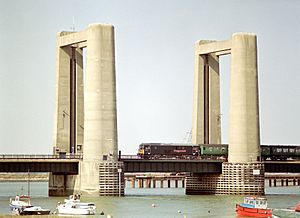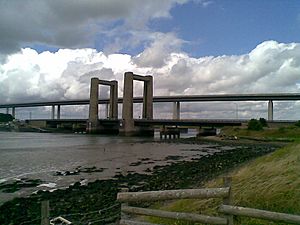Kingsferry Bridge facts for kids
Quick facts for kids Kingsferry Bridge |
|
|---|---|

Charter train on Kingsferry Bridge
|
|
| Coordinates | 51°23′27″N 0°45′01″E / 51.3907°N 0.7504°E |
| Carries | 2 lane road single track railway pedestrians |
| Crosses | The Swale |
| Locale | Isle of Sheppey, Kent, England |
| Characteristics | |
| Design | Vertical lift bridge |
| Width | 50 feet (15 m) |
| Longest span | 123 feet (37 m) |
| Clearance above | 120 feet (37 m) |
| History | |
| Opened | 20 April 1960 |
The Kingsferry Bridge is a special bridge that carries both a road and a railway. It connects the Isle of Sheppey to the rest of Kent in South East England. This bridge can lift its middle section up high. This allows big ships to sail underneath it.
The very first bridge here was built in 1860. It was for trains and helped connect Kent to the port of Sheerness. This old bridge was a bascule bridge, which means it could swing open. This allowed large boats to pass through the Swale river. In 1922, a ship hit the old bridge. It took 10 months to fix it. The old bridge was closed in the 1950s. The current Kingsferry Bridge replaced it.
The new bridge was designed by Mott, Hay and Anderson. It was built by John Howard, Dorman Long, and Sir William Arrol & Co.. The Swale railway station is at the south end of the bridge. When it first opened, many cars used the bridge every day. Now, most traffic uses the Sheppey Crossing, which opened in 2006. The Kingsferry Bridge is still an important way to get to the island.
Contents
History of the Kingsferry Bridge
The First Bridge
The first bridge on this spot was finished in 1860. It was a bascule bridge, designed for trains. It helped trains cross The Swale river. This connected the Isle of Sheppey to mainland Kent. The railway company used it to reach the port of Sheerness.
Later, in 1904, parts of the bridge were updated. On December 17, 1922, a Norwegian cargo ship called the Gyp crashed into the bridge. This caused a lot of damage. The bridge was closed for ten months for repairs. It stayed in use until the early 1950s. Then, the current Kingsferry Bridge replaced it.
Building the Current Bridge
By the late 1940s, people knew a new bridge was needed. The old bridge could not handle all the cars and people. More people wanted to drive instead of taking boats or trains. The new bridge was planned to have a road, train tracks, and a path for people walking. The height of the bridge was limited by the flat river banks. The railway also limited how steep the bridge could be.
Construction started in December 1957. The main builder was John Howard & Co. The steel parts came from Dorman Long. The machinery was made by Sir William Arrol & Co.. On April 20, 1960, the Duchess of Kent officially opened the bridge.
For many years, Kingsferry Bridge was the only way to get to Sheppey. Before the Sheppey Crossing opened in 2006, about 30,000 vehicles crossed the bridge daily. Drivers had to wait when the bridge lifted for boats. This usually happened at high tide. Each time it lifted, it took about 15 to 20 minutes.
The Kingsferry Bridge has lifted over 100,000 times. Each lift is recorded. In 2015, a local group tried to get the bridge recognized as a special historic building. However, English Heritage said it did not fit their rules for protection.
How the Bridge Works
The Kingsferry Bridge is a special bridge that lifts up. It has a two-lane road that is about 24 feet (7.3 meters) wide. It also has a 6-foot (1.8 meter) wide path for walkers. Plus, it carries a single train track. The train track is electric, but the lifting part of the bridge is not. Electric trains just roll across this part without power.
The bridge has two parts leading up to the middle. Each part has three sections. The middle section is the one that lifts. Each section is made of two strong steel beams. These beams hold up smaller beams, which support a concrete road surface.
The ends of the bridge are made of concrete. The main supports for the lifting part are strong concrete towers. These towers are hollow. They hold the cables and heavy counterweights that lift and lower the bridge. The towers are connected at the top by concrete beams.
Two large electric motors under the road move the bridge. There are rooms on each side with equipment. This equipment helps operate the ropes and counterweights that lift the bridge. The bridge can only lift when a train signalman gives permission. This ensures no trains are on the track section. The bridge can lift up to 84 feet high. When it reaches its full height, a horn sounds. Special devices make sure the lifting part lines up perfectly when it comes back down. If the power goes out, a backup diesel generator can provide electricity.



